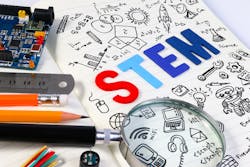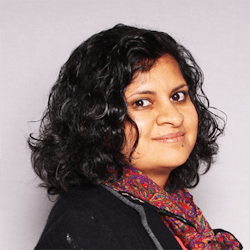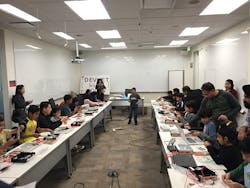As director of product management for Cisco DevNet over the last nine years, Shubha Govil has led several product lines in collaboration business. She is passionate about teaching and mentoring and runs several formal/informal programs to help people achieve their learning goals. As an advocate for STEAM (science, technology, engineering, art, and math) education, Govil also created the Cisco DevNet kids program to bring STEAM/IoT (Internet of Things) workshops to Cisco families.
Govil sat down with Machine Design to discuss STEAM education, the maker movement, and how we can move forward with educating our students. Govil talks a little about her background, Cisco DevNet for kids, and incorporating STEAM into students’ education and her upcoming workshop at the IEEE Women in Engineering International Leadership Conference in San Jose, Calif., May 22-23, 2017. Here are some excerpts from that conversation:
What is STEAM?
STEAM stands for Science, Technology, Engineering, Art, and Math. STEAM (and STEM) are the buzzwords that are driving parents of young children to enroll their budding scientists into camps to get them started in STEAM education. I first heard about STEAM a few years back when we decided to take my four year old son to Maker Faire Bay Area. At the time, I could not understand the value of calling out these subjects for the next generation. Little did I know that the Maker Faire would launch my passion for STEAM education.
How has STEAM impacted you?
Ever since our first Maker Faire Bay Area, we became regulars. However, 2015’s Maker Faire was a special event. My now eight-year-old son was attending this Faire as a maker exhibitor and I had the privilege of assisting him with his project. He had come up with a great product idea for kids, a programmable smartwatch kit that helps kids easily learn programming. He was selected out of 2,000 applications to showcase his smartwatch kit at the Faire. There is something contagious about the maker ecosystem that ignites the passion of making in kids as well as adults. It is also the power of STEAM that demonstrates to the next generation that anything is possible if you put your mind to the task at hand.
Eight-year-old instructor, Omkar Govil-Nair, introducing concepts of Arduino programming to a group of students in a DevNet Kids workshop at Cisco.
While we were at the Maker Faire, a research team from Arizona State University approached me asking how families of young makers support their kids and if it was their upbringing that encouraged them in that direction. I remember one question in particular that stood out to me. They asked, “What does engineering and STEAM mean to you?” To be honest, I had never considered this question before as I grew up an environment where engineering was a way of life.
You mentioned growing up in an engineering environment. What was that like and how did it affect you and your career?
I do not have a formal degree in engineering, but I did earn a master’s in economics from a leading technology institute (BITS, Pilani) in India where my father was a mechanical engineering professor. At the institute, true knowledge is quite literally worshipped in a temple that not only has all gods and goddesses of every religion, but also holds statues of hundreds of scientists, thinkers, philosophers, and artists who changed the course of life for all of humankind. I still remember spending my time staring at statues of great thinkers and inventors such as Gandhi, Edison, Newton, and Madame Curie. These statues were continuous reminders to all pupils to not only learn from our school education, but to also be curious, be agents of change, to follow our hearts, and to make those changes happen.
BITS, Pilani was full of resources including a library with an amazing collection of books and journals from around the world, including a rare collection of books and bound journals from the early 1900s, a Science Museum with curated exhibits, and a government electronics research lab. My dad would take us there during weekends where we would work on projects together that explored concepts of science and engineering. Another activity I enjoyed was going to the local observatory with my dad. He was very interested in astronomy and watching the night sky and shared that passion with me. I am thankful for a father that provided me with information and guidance about a variety of interest areas. However, his guidance did not push me to a specific career path, he let me choose my own passion and interest. This approach gave me the freedom to explore many different areas of interest during my life. Ultimately, because of my early exposure to science and engineering, I gravitated back toward that and began a science and engineering career.
Why is it important to incorporate STEAM into our children’s education?
In this day and age, there are plenty of tools and kits that allow young students the chance to experiment with concepts of engineering, science, and technology. Sadly, most schools are not equipped with these tools or don’t have the appropriate curriculum to allow for hands-on experimentation and learning. But, as they say, every big change starts with a small step. I wanted to make that big change and bring what I learned from the maker movement to my community.
To do this, I created a program for employee kids at my workplace, Cisco, and worked Cisco’s developer program, DevNet. DevNet helps developers and IT professionals write applications and develop integrations with Cisco products, platforms, and APIs. DevNet Kids is a program where we host workshops for kids that uses Ardunio, squishy circuits, and other maker tools to ignite creativity in young innovators. We were also able to take these workshops to STEAM Carnival in 2015 and Maker Faire 2016.
I might be slightly biased, but the most interesting part of these unstructured workshops is that my son is able to lead the sessions. The unstructured sessions make it easy and fun for students to learn as the environment is playful and led by another student. Watching another student teach the concepts and lead the sessions gives them the confidence to believe they can do it as well. Remembering these concepts comes more easily to these kids because they associate the sessions as a fun day spent at their parent’s office doing cool and awesome projects.
How do we move forward with STEAM education and the maker movement?
I believe we begin to move forward by digitizing everything around us. Digitization will drive the biggest change in our lives, in both social and political environments. It is no longer about a specific technology. Disruptive innovations are brought about by the combined experience created by different technologies. These experiences are not possible without the connectivity of systems, applications, tools, things, and people. It is truly the combination of atoms (physical things) and bits (the software-driven intelligence) that is needed for this digital era. It is up to us to enable this change by re-skilling ourselves and making sure our future generation is ready to adapt and leverage this change.
To make digitization, innovation, and STEAM real for every child and adult, we need to make engineering and making a part of our everyday lives. STEAM, and the maker movement, are combinations of knowing the principles of science, technology, engineering, art, and math, and further applying it to make this world a better place. So, centuries later, when the next generation of humankind is ready to worship their gods, they can create a place in their temple to worship the scientists, thinkers, innovators, artists, and leaders we are helping foster today.
I will be hosting an IoT workshop at the IEEE Women in Engineering International Leadership Conference that takes a simple approach to learning by using Arduino electronic prototyping kits to build a simple IoT application. This workshop is designed for anyone who is ready to get hands-on with maker tools and get started on their IoT projects in a supportive environment. I hope to see you there!



